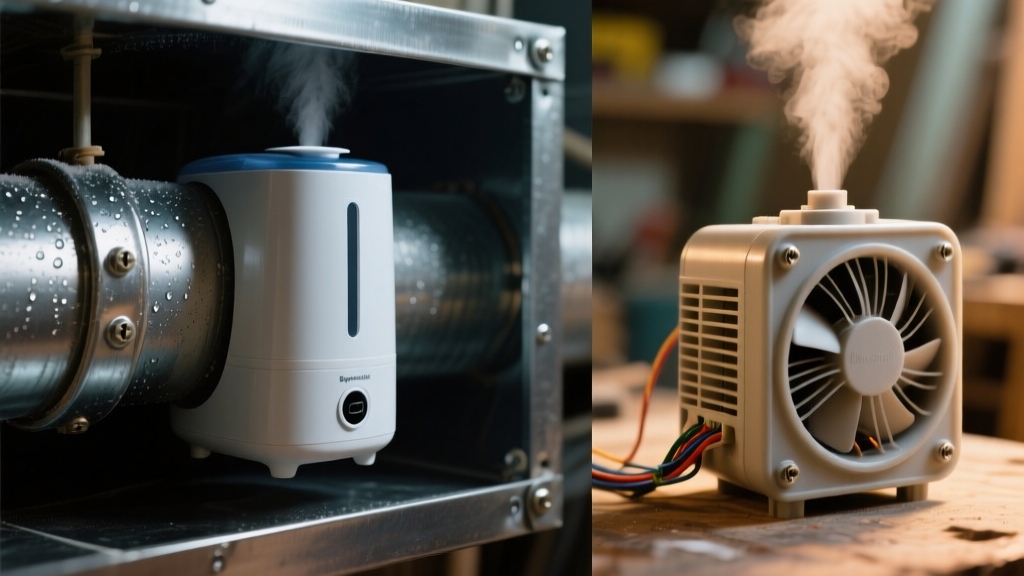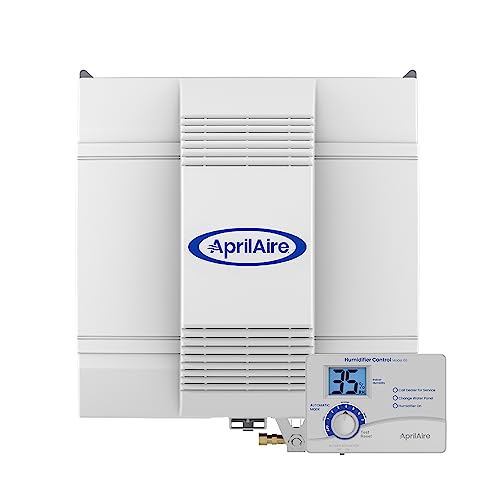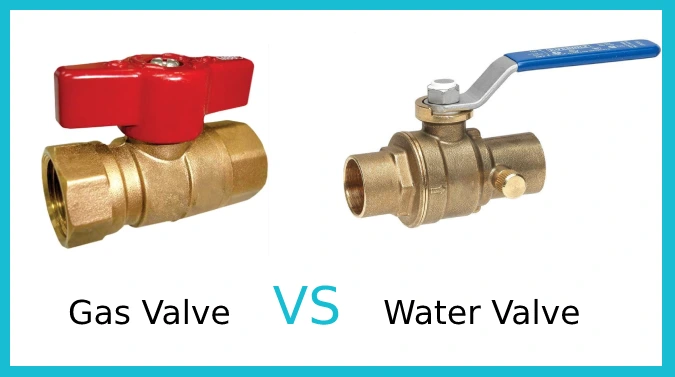Last Updated on October 23, 2025
You’ll find bypass humidifiers rely on your furnace blower to push air through a water panel, keeping them quieter and cheaper upfront. However, they only work when the furnace runs. Fan-powered humidifiers use an internal fan that actively circulates moisture independently.
This boosts output and control but costs more and generates some noise. Choosing between them depends on your home’s size, HVAC use, and noise tolerance. Exploring these details will clarify which suits your needs best.
- BALANCED HUMIDITY FOR HEALTH AND HOME PRESERVATION – Help minimize the formation of bacteria,…
- WHOLE-HOUSE HUMIDIFICATION – Deliver 12 gallons of moisture per day in homes up to 3,600 sq. ft….
- MANUAL CONTROL – The included Model 4655 Manual Humidistat monitors your home’s air providing…
- BUY WITH CONFIDENCE This humidifier was designed and manufactured in the USA by AprilAire – the…
- FULL COVERAGE up to 5,300 square feet in tightly built homes with a capacity of 18 gallons per day
- MANUAL HUMIDIFIER with a single sensor built into the standard control monitors indoor relative…
Key Takeaways
- Bypass humidifiers use furnace blower air, operate quietly, and cost less but only function during furnace operation cycles.
- Fan-powered humidifiers have an internal fan, provide consistent humidity independently, and deliver up to a gallon more moisture daily.
- Bypass units are simpler and cheaper to install, requiring a 6-inch duct and no electrical power, ideal for smaller or limited spaces.
- Fan-powered humidifiers need electrical power, more space, and produce more noise but offer superior humidity control year-round.
- Both require regular maintenance, with fan-powered units needing more complex servicing due to internal fans and electrical components.
Bypass vs Fan Powered Humidifier: Side-by-Side Comparison
| Feature | Bypass Humidifier | Fan Powered Humidifier |
|---|---|---|
| Initial Cost | Lower ($600-$700 installed) | Higher ($700-$800 installed) |
| Noise Level | Silent operation | Moderate sound (27dB minimum) |
| Energy Use | No additional electricity | Extra $40-$50 annually |
| Humidity Output | Depends on furnace operation | Up to 1 gallon more daily |
| Operation | Only when furnace runs | Independent of heating cycle |
| Installation | Requires 6-inch bypass duct | Needs 120V power supply |
| Maintenance | Simple with fewer parts | More complex motor checks |
| Lifespan | 10-15 years typical | 10-15 years with care |
| Best For | Smaller homes, budget-conscious | Larger homes, consistent humidity |
| Water Efficiency | Higher consumption | More efficient water use |
| HVAC Dependency | Completely dependent | Independent operation |
| Air Distribution | Limited to furnace airflow | Enhanced circulation |
How Bypass Humidifiers Work?
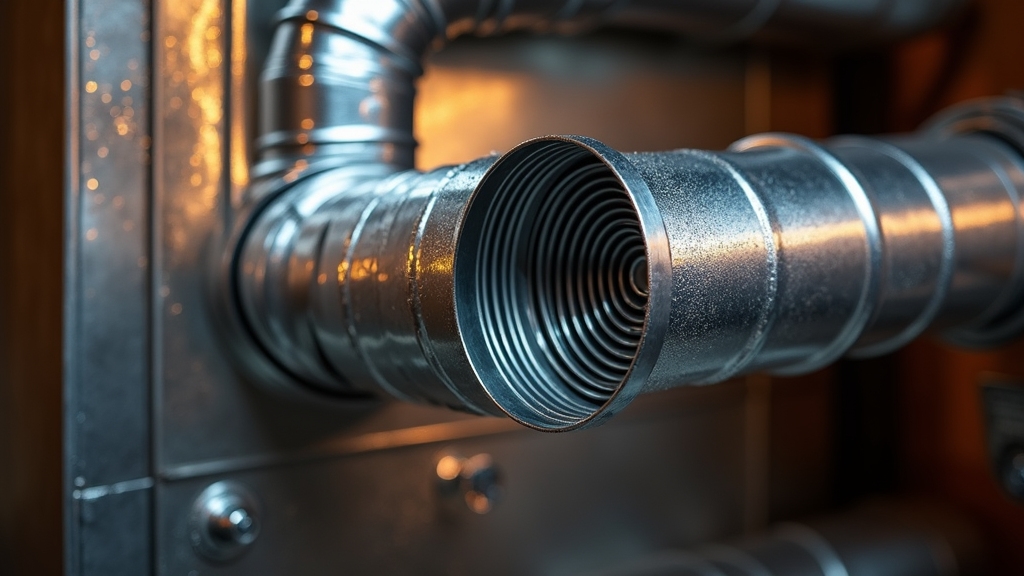
When you install a bypass humidifier, it connects to your HVAC system through a 6-inch duct that diverts warm air from the furnace blower across a water-saturated evaporative pad, adding moisture as air passes through. Proper installation requires a clean workspace and preparation to ensure safety and efficiency.
You’ll cut a 9.5” square opening in the plenum to mount the humidifier assembly, then attach the bypass duct securely to prevent sagging. A bypass damper regulates airflow, opening during heating seasons and closing in summer to prevent unnecessary operation.
This design leverages the furnace blower’s airflow without an internal fan, relying solely on HVAC air movement to evaporate water continuously fed over the pad. Bypass humidifiers circulate moisture via the air handler without its own fan, making them a common and low-maintenance option.
Moisturized air then returns to the supply ducts for distribution, controlled by a humidistat monitoring indoor humidity levels for ideal performance. Regular inspection and maintenance of components, similar to disassembling a submersible pump, help ensure long-term functionality.
Fan-Powered Humidifier Operation Explained
So, let’s talk about fan-powered humidifiers. You see, these nifty devices use an internal fan to really get the air moving over a water-saturated pad. This setup makes moisture evaporate more effectively and boosts airflow efficiency, especially when you compare it to bypass models. Pretty neat, right?
One of the best parts? You can count on consistent humidity delivery, even if your HVAC blower is taking a break. That’s a big plus!
But, just a heads-up: they do draw a bit more electrical power, and you might notice some operational noise. It’s all about weighing those trade-offs between performance and energy consumption in your system. Makes sense, doesn’t it?
Proper maintenance and inspection of internal components, similar to those in plumbing systems, help ensure efficient operation and prevent issues related to faulty valves and worn parts.
Internal Fan Functionality
Although bypass humidifiers depend on the HVAC blower’s pressure to divert air, fan-powered humidifiers incorporate an internal fan that actively pulls and circulates air over a water-saturated panel.
This fan forces air through channels flanking the panel, accelerating evaporation by increasing air contact and maintaining continuous airflow. You’ll find this internal fan allows the humidifier to operate independently of the HVAC blower, providing consistent humidity output even when the furnace is off.
The fan’s operation is precisely controlled by a humidistat, synchronizing air movement with water flow to prevent dry panel conditions.
This automatic control mechanism resembles how float switches in bilge pumps regulate operation based on water levels. While this active airflow enhances moisture delivery and stability, it also incurs higher electricity consumption compared to bypass units.
However, the energy cost remains modest and efficient relative to overall HVAC operation. Fan-powered humidifiers also typically include an evaporator pad inside that retains water, which is essential for effective humidification.
Airflow and Efficiency
Because fan-powered humidifiers incorporate an internal fan, they actively control airflow to maximize moisture transfer efficiency. This fan forces air through the water-saturated panel, markedly boosting evaporation rates compared to passive bypass units that rely solely on the HVAC blower.
As a result, you get up to one gallon more humidity daily with fan-powered models. Their internal fan maintains consistent humidification even during furnace low-speed or off cycles by supplementing airflow, which bypass humidifiers can’t do.
Additionally, fan-powered units distribute moisture evenly through the ductwork, improving whole-home humidity consistency. You’ll also find that these humidifiers reduce dependency on furnace blower speed, enhancing performance in variable-speed or multistage HVAC systems.
This precise airflow management leads to higher efficiency and more reliable humidity control across diverse operating conditions.
Furthermore, fan-powered humidifiers can operate independently of the heating system, allowing for humidification even when the furnace is not running, which increases overall convenience and comfort operate even when off. This design also helps reduce pressure drops in the duct system, contributing to improved HVAC performance.
Noise and Power Usage
Fan-powered humidifiers enhance airflow and moisture distribution through an internal fan. However, this operational feature also influences both noise levels and energy consumption. The high thermal conductivity of water in humidification systems helps optimize moisture transfer during operation.
You’ll notice that these units typically produce more noise than bypass humidifiers, which operate quietly without a fan. While some fan-powered models include noise-reduction features, they remain less common. So expect a moderate sound output. For example, certain models operate at a noise level as low as 27dB, which is notably quiet for fan-powered units.
On the energy front, fan-powered humidifiers consume more electricity due to the combined use of a fan and, in some cases, a heating element. However, efficient models can mitigate power usage, leading to modest cost savings over time.
If you prioritize quieter operation and lower energy consumption, bypass humidifiers are preferable. But fan-powered units offer faster humidification with increased operational energy demands and noise.
Comparing Noise Levels Between the Two Types
When evaluating humidifier options, you’ll notice that bypass models operate with virtually no additional noise since they lack built-in fans. They rely instead on the furnace blower for airflow.
Because they do not have their own fan, bypass humidifiers cannot run when the furnace is off, limiting their operation to times when the furnace blower is active. This design often makes installation simpler, similar to how pre-leveled bottoms facilitate easier setup in drop-in bathtubs.
In contrast, fan-powered humidifiers produce a consistent whirring sound from their internal fans. This can be louder and more noticeable, especially near quiet living spaces.
Noise mitigation for fan-powered units involves insulation or strategic placement. Bypass models require minimal intervention due to their silent operation.
Consider these key points:
- Bypass units add no mechanical noise beyond the furnace blower’s sound.
- Fan-powered units generate continuous fan noise during operation.
- Noise perception varies with home layout and room proximity to the furnace.
- Soundproofing can reduce fan-powered humidifier noise but not eliminate it entirely.
Choosing depends on your noise sensitivity and installation context.
Efficiency and Humidity Output Differences
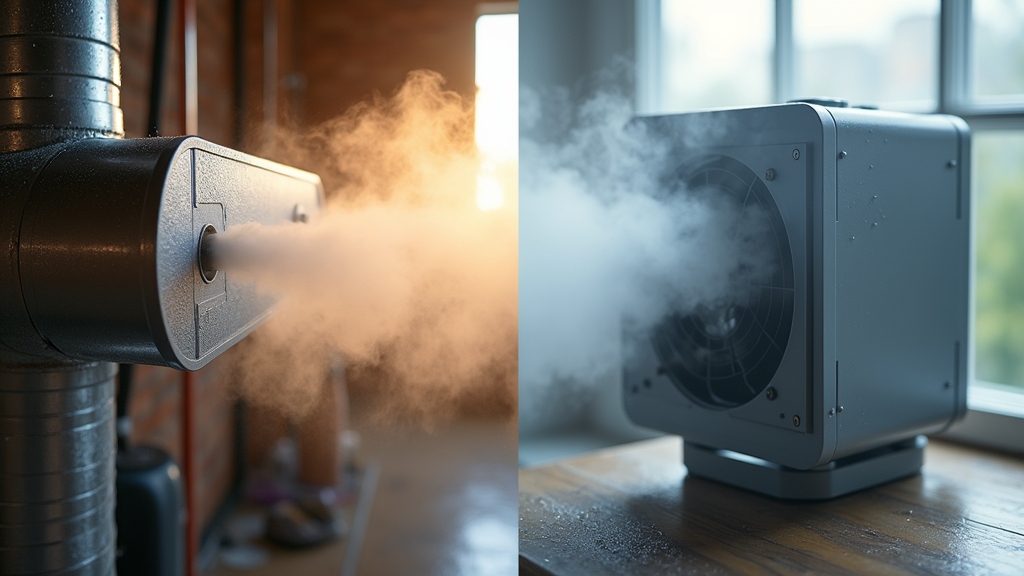
Beyond noise considerations, you should evaluate how each humidifier type handles efficiency and humidity output.
Bypass humidifiers depend on furnace operation, causing humidity loss as air passes through the blower, reducing efficiency. They also tend to consume more water to prevent mineral buildup, which further affects performance. Proper maintenance is necessary to avoid clogging and wear that can diminish their effectiveness.
In contrast, fan-powered humidifiers operate independently from the furnace, minimizing humidity loss and producing up to a gallon more moisture daily. Their internal fan enhances moisture distribution and maintains consistent humidity levels even when the furnace is off, making them more efficient overall.
Additionally, fan-powered units do not rely on the furnace’s blower system, offering greater compatibility with various HVAC setups (process difference). While fan-powered models use electricity for their fans, this energy cost is offset by superior moisture output and better performance, especially in larger homes where consistent, efficient humidification is critical.
Installation Requirements and Space Considerations
Although both bypass and fan-powered humidifiers integrate with forced-air systems, their installation demands differ considerably due to variations in electrical requirements, ductwork configuration, and spatial footprint.
Bypass units mount directly on plenums and need a 6″ bypass duct. Fan-powered units require 120V power for the blower and no bypass duct. Bypass units use a 6″ duct on plenums; fan-powered need 120V power but no bypass duct.
Space constraints favor bypass humidifiers for tighter mechanical rooms, whereas fan-powered models need more vertical clearance.
Both require proper sealing, water supply, and drain connections. However, fan-powered units increase electrical complexity.
Bypass units fit compact spaces; fan-powered units are bulkier due to blower assembly.
Fan-powered humidifiers need dedicated electrical circuits; bypass units do not.
Bypass ducts longer than 4 feet require support to prevent sagging.
Both systems must allow clearance for maintenance and comply with local codes.
Having a backup system, similar to the use of backup sump pumps, can provide additional reliability in humidifier operation.
Lifespan and Maintenance Needs
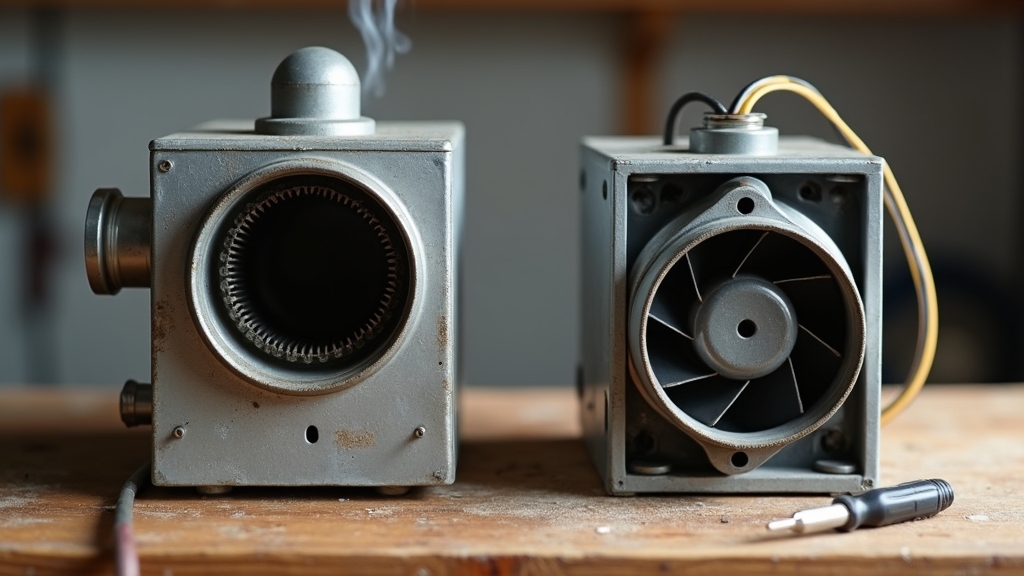
Bypass humidifiers usually have a pretty impressive lifespan, often lasting around 15 years if you take good care of them. Regular inspections and maintenance are recommended to ensure they continue working efficiently over time.
On the other hand, fan-powered units can stick around for about 10 to 15 years, but that really depends on how much you use and maintain them. Keeping an eye on common issues like water line clogs and scale deposits can prevent performance problems.
It’s important to remember that both types need regular maintenance. That means doing monthly cleanings and replacing the pads every year to avoid any mineral buildup. Regular upkeep not only extends the lifespan but also prevents mold, mildew, and bacterial growth.
If you want your humidifier to perform well and last a long time, you’ll want to stay on top of these tasks. Similar to maintaining a well, consistent care and monitoring help avoid costly repairs and ensure longevity. Plus, be aware of common issues like water line clogs and scale deposits—they can really impact your unit’s efficiency and durability if not dealt with.
Average Lifespan Comparison
When comparing humidifier types, you should consider that bypass models typically last around 10 years with proper maintenance, while fan-powered units average closer to 15 years due to their more durable components. Lifespan depends on usage intensity, water quality, and upkeep. Regular maintenance to prevent mineral buildup is crucial for both types to maintain performance and longevity.
Key factors include:
- Bypass units may reach 15 years with exceptional care; typical expectancy is 10 years.
- Fan-powered humidifiers’ robust design and integrated fans enhance longevity.
- Mineral buildup and corrosion critically reduce lifespan in both types.
- Water efficiency in fan-powered units lowers scaling, supporting extended durability.
Additionally, the operational behavior of fan-powered humidifiers allows for continuous running, which can contribute to more consistent maintenance and potentially longer lifespan.
Understanding these distinctions helps you select a humidifier aligned with your household’s demands and expected service life.
Maintenance Frequency Required
Since proper maintenance directly influences both performance and lifespan, you need to follow specific service intervals for bypass and fan-powered humidifiers.
Both require at least annual servicing, including disconnection of power and water supplies for safety. You’ll flush strainers and drain hoses and inspect feeder tubes for damage, replacing parts as needed.
Humidifier pads demand yearly replacement, more frequently in hard water areas or high-demand conditions. For bypass systems, you can replace pads yourself; fan-powered units benefit from professional service due to complexity.
Cleaning with vinegar-based solutions removes mineral deposits, which is vital to prevent efficiency loss. Seasonal shutdown cleaning further prolongs system life. Additionally, it is important to turn off water and power before beginning any maintenance to ensure safety.
Manufacturer guidelines and water hardness levels directly affect maintenance frequency, so adhering strictly to prescribed intervals ensures ideal operation.
Common Maintenance Challenges
Although both bypass and fan-powered humidifiers require regular upkeep, you’ll face distinct maintenance challenges tied to their design and operational complexity.
Bypass units generally last longer due to fewer mechanical parts but demand manual damper adjustments and more frequent water panel replacements caused by inefficient water use.
Additionally, bypass humidifiers rely on the furnace blower to operate, meaning maintenance of the furnace system can indirectly affect their performance and longevity, highlighting the importance of furnace dependency.
Fan-powered units feature integrated fans requiring frequent motor inspections and electrical checks, increasing maintenance complexity and cost.
Key maintenance challenges include:
- Mineral buildup on water panels impairing efficiency in both types
- Regular lubrication and inspection of fan motors in fan-powered units
- Seasonal bypass damper adjustments to optimize airflow in bypass models
- Increased repair frequency and part replacement costs for fan-powered humidifiers
Understanding these challenges helps you optimize lifespan and performance effectively.
Cost Analysis: Upfront and Operating Expenses
Two primary cost components define the financial impact of choosing between bypass and fan-powered humidifiers: upfront expenses and ongoing operating costs.
Bypass humidifiers generally cost around $100 less initially, averaging $600-$700 installed, due to simpler construction without a motor. However, installation can be more labor-intensive and costly because of necessary ductwork modifications.
Fan-powered units, priced around $700-$800 installed, include an internal fan and require a 120-volt power supply, which can complicate installation if electrical upgrades are needed.
Operating costs differ as bypass humidifiers rely on the furnace blower, incurring no extra electricity expense. In contrast, fan-powered humidifiers consume additional power, typically costing $40-$50 annually.
Water usage and maintenance also influence long-term expenses, but upfront and energy costs remain critical in your financial evaluation. Maintaining indoor humidity levels between 40-60% not only enhances comfort but can also help reduce illness, making the choice of humidifier impactful beyond just cost.
Choosing the Right Humidifier for Your Home
Understanding the operational differences between bypass and fan-powered humidifiers helps you make an informed choice tailored to your home’s needs. If your furnace runs frequently and you have existing ductwork, a bypass humidifier offers silent operation without extra energy costs.
However, for consistent humidity control independent of heating cycles, fan-powered units excel, especially in larger homes. Consider these factors when choosing:
- Airflow needs: passive vs. active moisture delivery
- Energy consumption: furnace-dependent vs. dedicated power use
- Installation complexity: ductwork requirements vs. standalone setup
- Maintenance demands: mechanical fan care vs. simpler water panel cleaning
A professional assessment helps determine the most suitable humidifier type and size based on your home’s specific requirements and HVAC compatibility, ensuring optimal system performance.
Frequently Asked Questions
Can Either Humidifier Type Improve Indoor Air Quality Beyond Adding Moisture?
Neither humidifier type directly improves indoor air quality beyond adding moisture. They don’t remove dust, allergens, or pollutants from the air.
However, by raising humidity to ideal levels, you can reduce irritation of skin and respiratory passages, indirectly enhancing comfort.
Keep in mind, excessive moisture can promote mold and dust mites, which degrade air quality. You’ll need regular maintenance to prevent these negative effects.
Are There Health Risks Associated With Using Bypass or Fan-Powered Humidifiers?
Yes, you face health risks if you don’t install or maintain humidifiers properly.
Excess moisture promotes mold growth, worsening respiratory issues like asthma and allergies.
Both types can cause condensation in ducts, fostering microbial proliferation.
Over-humidification above 50% encourages dust mites and bacteria.
Mineral dust from hard water may also irritate airways.
Regular cleaning, water quality checks, and controlled humidity levels are essential to reduce these health hazards effectively.
How Do These Humidifiers Affect Allergy or Asthma Symptoms?
Imagine breathing crisp, moist air soothing your irritated throat.
Fan-powered humidifiers deliver steady, enhanced moisture, easing allergy and asthma symptoms by preventing dry, scratchy air. They maintain consistent humidity even when heating’s off, reducing mucous membrane irritation.
Bypass units work only with furnace airflow, offering less moisture and potentially less relief. You might notice quieter operation with bypass, but fan-powered systems better stabilize indoor air, helping you breathe easier and feel more comfortable.
Can These Humidifiers Be Integrated With Smart Home Systems?
Yes, you can integrate both humidifier types with smart home systems, but it requires additional hardware.
You’ll often need smart relays or wiring modifications to connect them to smart thermostats like Nest or Ecobee. Bypass models connect more straightforwardly via humidifier terminals, while fan powered units may need extra relays or firmware support.
What Are Common Troubleshooting Tips for Humidifier Malfunctions?
When your humidifier acts up, think of it as a puzzle needing careful diagnosis.
First, confirm power is steady: check cords, breakers, and control locks.
Next, verify water flow: tank full, lines clear, valves unclogged.
Clean filters and mineral deposits to keep airflow smooth.
Listen for fan sounds and observe water cycling.
Replace worn pads annually.
Address odors by disinfecting parts and using distilled water.
These steps pinpoint common malfunctions precisely.
Conclusion: Time to Upgrade Your Home’s Humidity Control System
When choosing between a bypass and a fan-powered humidifier, picture your HVAC system’s airflow as a river. A bypass humidifier gently channels moisture without added noise, while a fan-powered unit actively pushes humidified air, boosting output but increasing sound and energy use.
Consider your space, installation limits, and maintenance willingness. By analyzing these factors, you’ll select a system that balances efficiency, comfort, and cost, ensuring your home’s air feels just right all year.
- BUY WITH CONFIDENCE This humidifier was designed and manufactured in the USA by AprilAire – the…
- FULL COVERAGE up to 5,300 square feet in tightly built homes with a capacity of 18 gallons per day
- AUTOMATIC HUMIDIFIER with dual sensors to monitor and respond to both outdoor temperature and indoor…
- BALANCED HUMIDITY FOR HEALTH AND HOME PRESERVATION – Help minimize the formation of bacteria,…
- WHOLE-HOUSE HUMIDIFICATION – Deliver 17 gallons of moisture per day in homes up to 5,000 sq. ft….
- MANUAL CONTROL – The included Model 4655 Manual Humidistat monitors your home’s air providing…
Last update on 2025-12-07 / Affiliate links / Images from Amazon Product Advertising API

